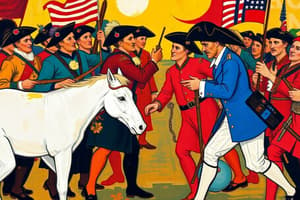Podcast
Questions and Answers
What was Thomas Paine's occupation after arriving in Philadelphia in 1774?
What was Thomas Paine's occupation after arriving in Philadelphia in 1774?
- A teacher
- A politician
- A journalist (correct)
- A merchant
What is the main argument of Part One in 'Common Sense'?
What is the main argument of Part One in 'Common Sense'?
- The American colonies should separate from Great Britain
- Kings and queens should have absolute power
- Government is necessary to protect society (correct)
- A monarchy is the best form of government
Why did Thomas Paine oppose the idea of a monarchy?
Why did Thomas Paine oppose the idea of a monarchy?
- He believed all men were created equal and no one should have authority over others (correct)
- He believed kings and queens were too powerful
- He wanted to become a king himself
- He thought monarchies were outdated
What is the significance of 'Common Sense' in American history?
What is the significance of 'Common Sense' in American history?
Where was Thomas Paine born?
Where was Thomas Paine born?
What was Paine's main concern about the rulers of the American colonies?
What was Paine's main concern about the rulers of the American colonies?
According to Paine, what was Great Britain's motivation for supporting the American colonies?
According to Paine, what was Great Britain's motivation for supporting the American colonies?
What was Paine's suggestion for the formation of a new government in the American colonies?
What was Paine's suggestion for the formation of a new government in the American colonies?
What was the outcome of the Second Continental Congress five months after 'Common Sense' was published?
What was the outcome of the Second Continental Congress five months after 'Common Sense' was published?
What was the main effect of 'Common Sense' on the American Revolution?
What was the main effect of 'Common Sense' on the American Revolution?
Flashcards are hidden until you start studying
Study Notes
Thomas Paine and His Influence
- Thomas Paine used writing to share his ideas and opinions during colonial times when there were no computers, radios, or televisions.
- He was born in Great Britain, but wanted America to separate from it.
- Paine met Benjamin Franklin in London, who convinced him to move to America.
- In 1774, he arrived in Philadelphia and became a journalist.
Common Sense
- 'Common Sense' is a 48-page pamphlet written by Thomas Paine that explains why America should separate from Great Britain.
- It's considered one of the most influential pieces of writing in American history.
- The pamphlet is divided into four sections that discuss government, society, monarchy, and independence.
- In Part One, Paine argues that government is necessary to protect society, but it should not be ruled by a monarch.
- In Part Two, he opposes the idea of monarchy, believing that all men are created equal and should not be ruled by one person.
Arguments Against Monarchy
- Paine argues that monarchy leads to unqualified and unfair rulers based on birthright rather than merit.
- He believes that people should have a say in their government and leaders.
- The idea of monarchy goes against the principle of equality.
Independence and a New Government
- Paine suggests that America would be better off separating from Great Britain and forming its own government.
- He proposes a system where the people can vote for their leader and have a written constitution.
- He believes America will become more respected, successful, and wealthy if it separates from Great Britain.
Impact on the American Revolution
- 'Common Sense' was published at a time when the colonies were angry with Great Britain, and it gained support for independence.
- Five months after its publication, the Second Continental Congress met and wrote the Declaration of Independence.
- 'Common Sense' is considered the best "commercial" for the American Revolution.
Studying That Suits You
Use AI to generate personalized quizzes and flashcards to suit your learning preferences.




